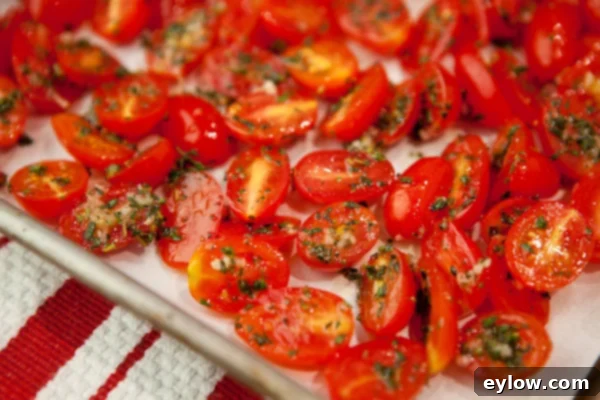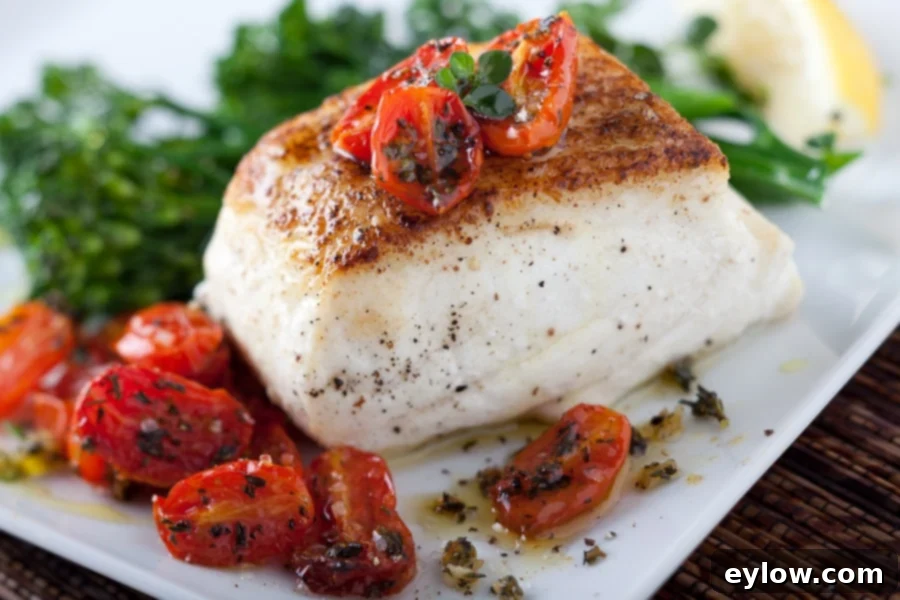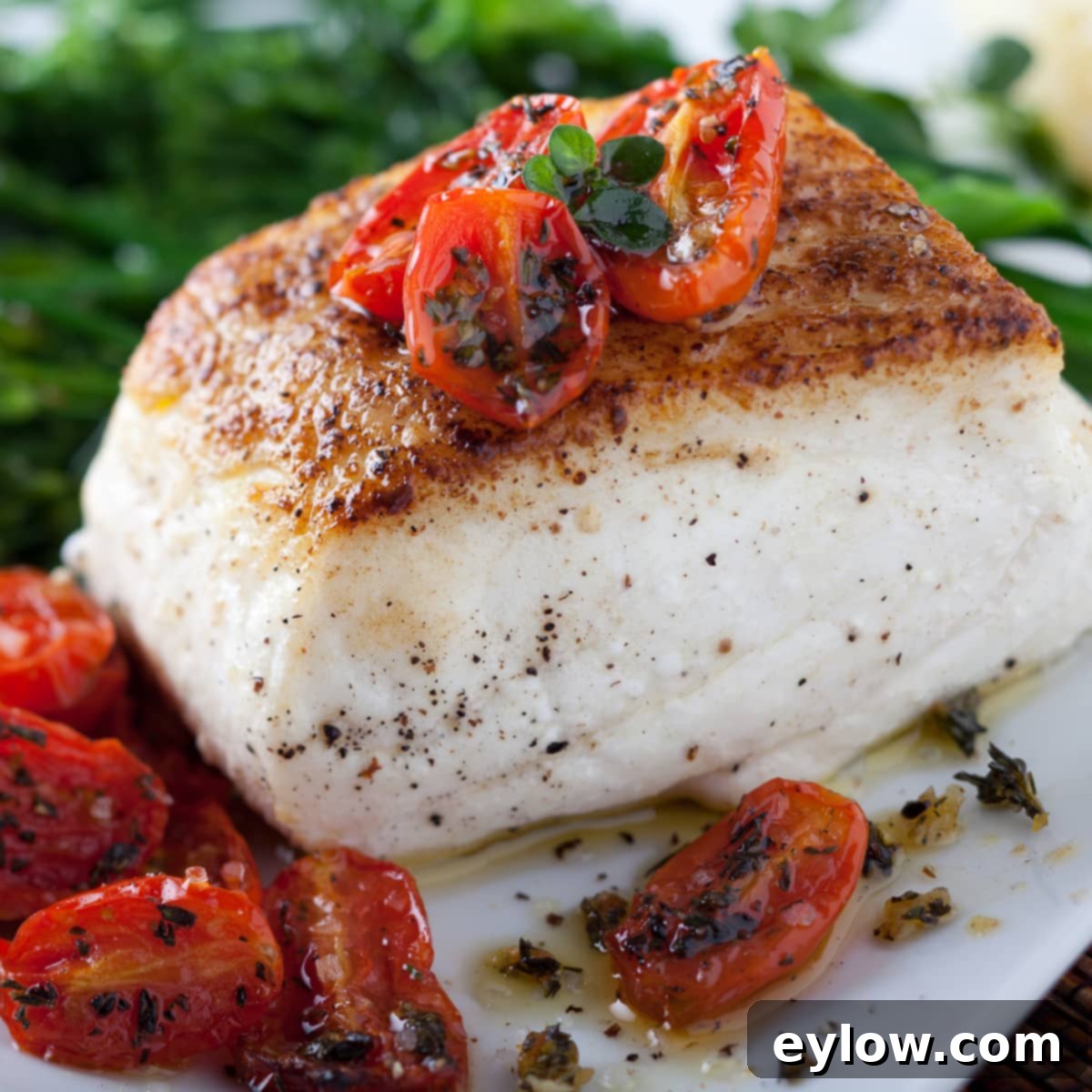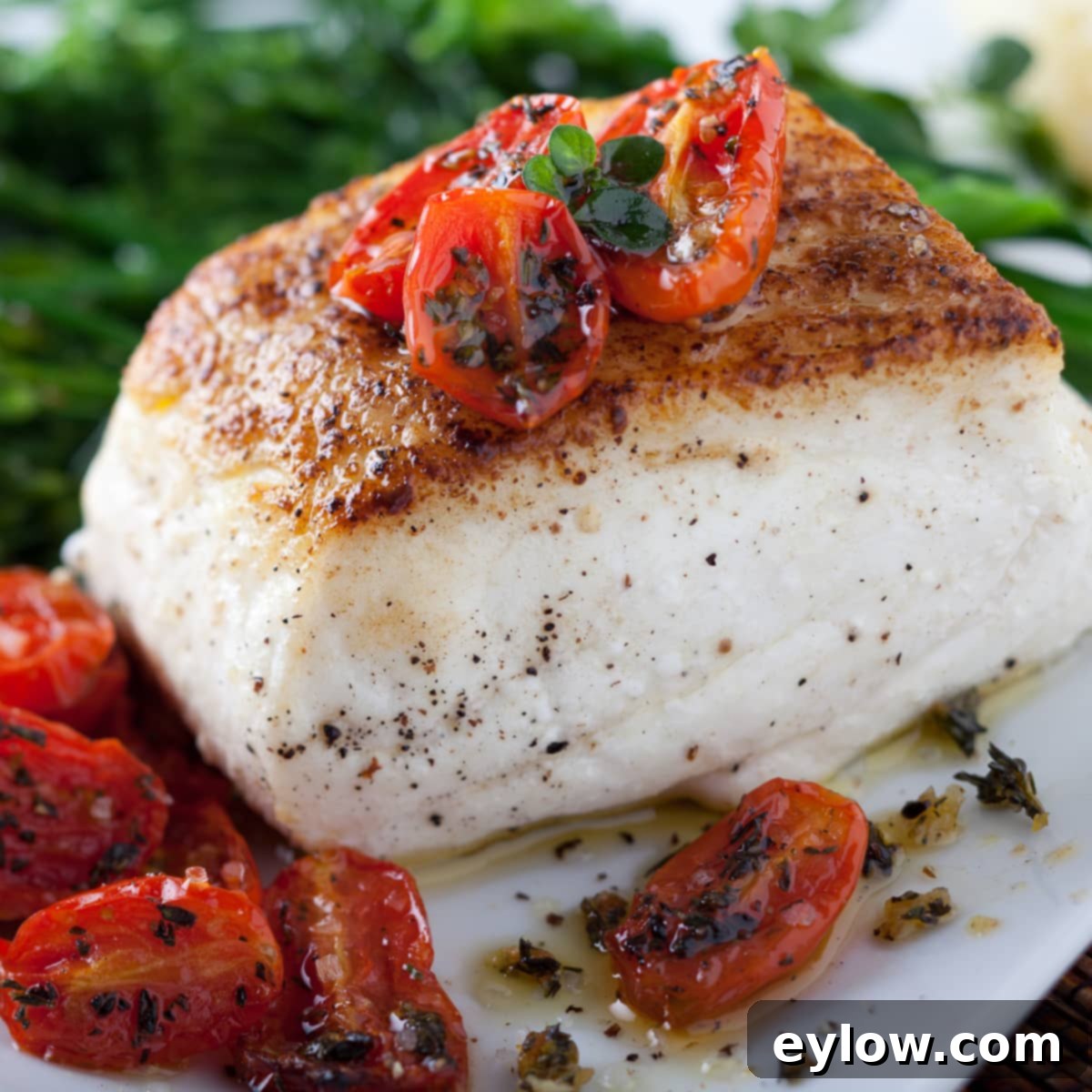Perfectly Baked Halibut with Roasted Cherry Tomatoes: An Easy & Healthy Dinner
There’s nothing quite like the delicate, mild flavor and pearly white flesh of fresh halibut. For many, the arrival of spring signifies not only warmer weather but also the start of halibut season, bringing with it the promise of light, healthy, and incredibly delicious meals. This recipe for baked halibut paired with sweet, savory roasted cherry tomatoes offers a culinary experience that is both simple to prepare and exquisitely flavorful. Inspired by a leftover container of cherry tomatoes, this dish transforms everyday ingredients into a restaurant-quality meal, perfect for any weeknight or special occasion.

While fresh halibut can be a premium choice, focusing on proper portion control makes it a surprisingly economical option compared to dining out. Each bite of this tender fish, complemented by the concentrated sweetness and herbaceous notes of roasted tomatoes, justifies the investment. Plus, any extra roasted tomatoes are a delightful bonus, perfect for enhancing salads, omelets, or even as a simple spread.
This recipe emphasizes fresh, seasonal ingredients and straightforward cooking techniques, making it accessible for home cooks of all skill levels. It’s a testament to how simple, quality ingredients can create an unforgettable dining experience.
Why You’ll Love This Easy Halibut and Tomato Recipe
- Embraces Seasonal Flavors: This dish truly shines when fresh halibut is in season, perfectly complemented by the natural sweetness of ripe cherry tomatoes. It’s a celebration of spring and summer produce.
- Convenient Preparation: The roasted tomatoes can be prepared in advance, saving valuable time on busy weeknights. This allows for a quicker assembly and cooking process when dinner time rolls around.
- Exquisite Flavor Profile: The combination of mild, flaky halibut, deeply caramelized cherry tomatoes, aromatic garlic, and fresh thyme creates a symphony of flavors that is both comforting and sophisticated.
- Healthy and Nutritious: Halibut is an excellent source of lean protein and omega-3 fatty acids, while cherry tomatoes are packed with vitamins and antioxidants. This meal is a powerhouse of nutrition without sacrificing taste.
- Adaptable to Various Diets: Naturally gluten-free and low-carb, this recipe is easily adjusted to fit different dietary preferences. It’s a wholesome choice for anyone looking for a clean eating option.
- Simple yet Elegant: Despite its ease of preparation, this dish looks and tastes impressive, making it suitable for both casual family dinners and more formal entertaining.
Essential Recipe Ingredients
Crafting this delightful dish relies on a few key ingredients. Opting for the freshest possible produce and seafood will elevate the flavors significantly.
For Roasted Cherry Tomatoes
- Cherry Tomatoes or Grape Tomatoes: The star of the accompaniment! Choose plump, ripe tomatoes, whether all red for classic appeal or a vibrant mix of colors for an attractive presentation. Halving them before roasting allows their natural sugars to caramelize beautifully.
- Olive Oil: A good quality extra virgin olive oil is essential for tossing the tomatoes. It helps them roast evenly, imparts a rich flavor, and contributes to their beautiful golden-brown edges.
- Fresh Garlic: Finely chopped or zested fresh garlic infuses the tomatoes with a pungent, aromatic flavor that mellows and sweetens during roasting. Using a microplane makes quick work of zesting.
- Fresh Herbs: Fresh thyme is highly recommended for its earthy, slightly floral notes that pair wonderfully with both tomatoes and fish. If fresh thyme isn’t available, other options are discussed in the “Substitutions and Variations” section.
- Salt and Freshly Ground Black Pepper: To season the tomatoes and enhance their natural sweetness and savory depth.
For Baked Halibut
- Fresh Halibut Fillets: The quality of your halibut is paramount. Aim for thick, firm, pearly white fillets, ideally 1 to 2 inches thick. The cooking method can be easily adjusted based on the thickness of your fish.
- Olive Oil: Halibut is a very lean fish, so a drizzle of olive oil before searing and roasting is crucial. It prevents sticking, adds moisture, and complements the fish’s delicate flavor.
- Lemon: Fresh lemon wedges are a non-negotiable garnish. A squeeze of fresh lemon juice over the cooked halibut and tomatoes brightens the entire dish and adds a refreshing tang.
- Salt, Pepper, and Granulated Garlic: Basic seasonings to bring out the best in the halibut. Granulated garlic offers a consistent flavor without the risk of fresh garlic burning during searing.
Substitutions and Variations to Customize Your Meal
While this recipe is fantastic as written, it’s also incredibly versatile. Feel free to adapt it based on ingredient availability or your personal preferences.
- Herb Alternatives: If fresh thyme isn’t on hand, fresh rosemary offers a wonderful, slightly stronger herbaceous note. For dried herbs like dried thyme or a classic Herbs de Provence blend, mix them with the olive oil a little while before tossing with the tomatoes. This allows the dried herbs to rehydrate and their flavors to “bloom” fully before roasting. Dried oregano or a pinch of red pepper flakes for a subtle kick would also be excellent.
- Other Fish Options: This cooking method and tomato accompaniment work beautifully with other firm, white-fleshed fish. Fresh cod fillets, snapper, grouper, or even thick salmon fillets are excellent substitutes. Adjust cooking times based on the thickness and type of fish.
- Vegetable Additions: Enhance the roasted tomatoes by adding other quick-cooking vegetables to the baking sheet. Asparagus spears, bell pepper strips, thinly sliced zucchini, or even small broccoli florets would roast nicely alongside the tomatoes, adding more color and nutrients.
- Spice It Up: For a touch of heat, sprinkle a pinch of red pepper flakes over the tomatoes or season the halibut with a hint of cayenne pepper.
- Citrus Variations: Instead of lemon, consider lime wedges for a different citrusy twist, especially if using an Asian-inspired marinade for the fish (though this recipe leans Mediterranean).
- Garlic Prep: If you don’t have a microplane, finely mincing the fresh garlic cloves with a sharp knife works just as well.
Step-by-Step Recipe Instructions for a Flawless Meal
Preparing this dish is straightforward, with two main components: the roasted tomatoes and the baked halibut. Let’s start with the vibrant tomatoes.
1. Prepare and Roast the Cherry Tomatoes
To begin, pre-heat your oven to 375°F (190°C). Line a rimmed baking sheet with parchment paper or foil for easy cleanup. In a medium bowl, combine your halved cherry or grape tomatoes. Add a generous tablespoon of fresh chopped thyme leaves (or your chosen herb), a couple of finely minced or zested fresh garlic cloves, a drizzle of olive oil, and a pinch of salt and pepper. Toss everything together until the tomatoes are evenly coated.
Spread the seasoned tomatoes in a single layer on the prepared baking sheet. Roast for 20-25 minutes. The goal is for them to shrivel slightly, release their juices, and for the edges to begin browning and caramelizing. Roasting the tomatoes concentrates their natural sweetness, developing an amazing depth of flavor that complements the fresh thyme perfectly. If using a convection oven, they might cook a bit faster, so keep an eye on them.

2. Expert Tips for Buying Fresh Halibut
When purchasing fresh halibut, aim for about 4-6 ounces per person. This portion size is not only excellent for controlling your intake but also for managing your budget, as halibut can be a pricier fish. Look for fillets that are firm, moist, and have a translucent, pearly white color. Avoid any fish that looks dry, discolored, or has a strong “fishy” odor; it should smell clean, like the ocean. Thicker fillets (1.5 to 2 inches) are often preferred for their ability to remain moist during cooking and develop a beautiful crust, but thinner fillets work perfectly well with adjusted cooking times.
If buying from a fishmonger, don’t hesitate to ask when the fish arrived and how fresh it is. They can also often cut fillets to your desired thickness. For sustainability, look for halibut that is responsibly sourced, often indicated by certifications like the Marine Stewardship Council (MSC).
3. Understanding Baked Halibut: Different Cooking Methods
There are several effective ways to cook halibut, and the best method often depends on the thickness of your fillet. The restaurant trick of searing halibut on the stovetop and then finishing it quickly in a hot oven is ideal for thicker cuts, ensuring a beautiful golden crust and a moist interior. This entire process can take as little as 10 minutes.
For thinner local halibut fillets, common during certain seasons or in specific regions, you can adapt the cooking time. A very thin fillet might only need a minute or two in the oven after searing, or it can even be cooked entirely on the stovetop. Cod fillets are also a great alternative for this stovetop-only method. Always choose the freshest fish available in your area.
For thinner fillets, two primary options exist:
- Oven-Baked Only: Skip the initial sear and bake the seasoned fillets directly in the oven. This method won’t yield a browned crust but still produces tender, flaky fish.
- Searing and Stovetop Finish: Sear the fish on one side until golden, then flip it. Splash in a little white wine or chicken broth, cover the pan immediately, and let it finish cooking for a few minutes on the stovetop until opaque. This steams the fish gently while retaining moisture.
Each cooking method delivers delicious results, so choose the one that best suits the thickness and type of fish you have.

4. How to Cook the Halibut: The Sear and Roast Method
This method provides the best of both worlds: a crispy exterior and a tender, flaky interior.
- Prepare the Fish: If your halibut fillets are cold from the refrigerator, let them sit at room temperature for about 45 minutes to an hour. This helps them cook more evenly. Pat them thoroughly dry with paper towels to ensure a good sear. Season generously with salt, freshly ground black pepper, and granulated garlic on all sides.
- Preheat Oven and Pan: While the fish warms, pre-heat your oven to 425°F (220°C). Place a non-stick oven-safe pan (or a cast-iron skillet) over medium-high heat and drizzle in a tablespoon of olive oil. Ensure your pan is hot enough; the oil should shimmer but not smoke.
- Sear the Halibut: Carefully place the halibut fillets into the hot pan, presentation side (the side you want facing up when served) down. You should hear a distinct sizzle. Allow the fish to sear undisturbed for about 3 minutes, or until a beautiful golden-brown crust forms when you peek underneath.
- Flip and Quick Sear: Gently flip the fish over and sear for just 1 minute longer on the second side. This quick sear locks in flavor and begins the cooking process.
- Finish in the Oven: Transfer the pan (if oven-safe) or carefully move the seared halibut fillets to the parchment-lined baking sheet you prepared earlier. Roast in the preheated 425°F (220°C) oven for approximately 6 minutes for fillets that are 2 inches thick. For thinner fillets, reduce the cooking time accordingly. Halibut cooks relatively quickly, so precise timing is key to avoid overcooking.
5. How to Tell When Your Halibut is Perfectly Done
The key to succulent halibut is to avoid overcooking. Perfectly cooked halibut will be moist, tender, and barely translucent in the very center, not dry and flaky throughout. Overcooked fish can become tough and lose its delicate flavor.
- Temperature Check: The most accurate way to check for doneness is with a digital thermometer. Insert the thermometer into the thickest part of the fillet; it should reach an internal temperature of 140°F – 145°F (60°C – 63°C). Remember that the fish will continue to cook slightly after it’s removed from the oven (carryover cooking).
- Flake Test: Gently press on the thickest part of the fish with a fork or your finger. The flesh should feel firm but still have a slight give, and it should flake easily.
- The “Lip Test” (or Cake Tester Method): If you don’t have a digital thermometer, use a thin metal skewer or a cake tester. Insert it into the middle of the fillet for about 5 seconds, then quickly remove it and touch it to your upper lip or inner wrist. If the skewer feels warm (not scalding hot, but definitely warm), the fish is ready. This seemingly unusual method is surprisingly effective for gauging the internal temperature.

6. Finish and Serve Your Culinary Masterpiece
Once the halibut is cooked to perfection, transfer it carefully to serving plates. Drizzle each fillet with a little bit of high-quality finishing olive oil – this adds a luxurious sheen and enhances the flavor. A generous squeeze of fresh lemon juice over the fish and tomatoes will brighten all the flavors and add a refreshing zing.
Spoon a generous amount of the warm roasted cherry tomatoes alongside or directly over the halibut. For an extra touch of freshness and color, garnish with finely chopped fresh parsley, thyme, or chives, if desired. Serve immediately and enjoy the exquisite flavors of this simple yet elegant dish.

Serving Suggestions for a Complete Meal
This baked halibut with roasted cherry tomatoes is quite complete on its own, but it pairs beautifully with a variety of side dishes to create a well-rounded meal. Consider serving it with:
- A simple green salad with a tangy vinaigrette.
- Steamed or sautéed green beans, asparagus, or broccoli.
- Quinoa, couscous, or a light rice pilaf to soak up the delicious juices.
- Roasted new potatoes or a creamy mashed potato side.
- A slice of crusty bread to mop up any remaining tomato goodness.
Storage and Reheating Tips
While this dish is best enjoyed fresh, leftovers can be stored and enjoyed later.
- Storage: Store any leftover halibut and roasted tomatoes in separate airtight containers in the refrigerator for up to 2-3 days.
- Reheating Halibut: Reheating fish can be tricky as it tends to dry out. For best results, gently reheat halibut in a preheated oven at 275°F (135°C) for about 10-15 minutes, or until just warmed through. You can also microwave it briefly on a low setting, but be careful not to overcook.
- Reheating Tomatoes: Roasted cherry tomatoes can be reheated in the microwave or a low oven until warm. They are also delicious served cold or at room temperature, making them perfect for adding to salads or sandwiches.
📖 Recipe: Baked Halibut with Roasted Cherry Tomatoes
Mild, meaty halibut seared and roasted, then topped with sweet, herb-roasted baby tomatoes, makes a terrific, easy, and healthy dinner. Serve with a green vegetable and a tossed green salad with a tangy vinaigrette. Choose thick halibut fillets if possible for the best results.

Prep Time: 25 mins
Cook Time: 10 mins
Total Time: 35 mins
Yields: 4 servings
Cuisine: American
Course: Dinner, Fish, Seafood
Calories: 183 kcal per serving
Equipment
- Non-stick pan (for searing fish)
- Half sheet baking tray (for roasting tomatoes and baking fish)
Ingredients
Roasted Cherry Tomatoes
- 16 ounces sweet cherry tomatoes, halved
- 1 tablespoon olive oil
- 2 large garlic cloves, finely chopped or zested
- 1 ½ tablespoons fresh chopped thyme leaves
- ¼ teaspoon sea salt
- ⅛ teaspoon ground black pepper
Baked Halibut
- 4 (4 ounce) halibut fillets (thicker is better)
- ¼ teaspoon sea salt (to taste)
- ¼ teaspoon ground black pepper
- 1 tablespoon olive oil
- 4 lemon wedges (optional, for serving)
Instructions
- Prepare the Halibut: If your fish is cold from the refrigerator, allow it to stand at room temperature for 45 minutes to an hour to take the chill off. This ensures more even cooking.
- Prepare for Baking: Line a rimmed baking sheet with parchment paper or foil and set aside.
- Roast the Tomatoes: Pre-heat the oven to 375°F (190°C). In a small bowl, toss the halved cherry tomatoes with 1 tablespoon olive oil, finely chopped garlic, fresh thyme, ¼ teaspoon sea salt, and ⅛ teaspoon ground black pepper. Spread the tomatoes on a separate prepared baking sheet. Roast for 20-25 minutes, or until shriveled and the edges are just starting to brown. (Timing may vary based on your oven.)
- Preheat for Halibut: While the tomatoes are roasting, pre-heat the oven to 425°F (220°C) for the halibut.
- Sear the Halibut: Place a non-stick skillet or frying pan over medium-high heat and add 1 tablespoon of olive oil. Season halibut fillets with salt and pepper. When the oil is hot but not smoking, place the halibut presentation side down in the pan. Allow a golden crust to form, about 3 minutes.
- Finish Searing: Carefully turn the halibut over and sear for 1 minute longer on the second side.
- Bake the Halibut: Remove the seared halibut to your prepared baking sheet (the one reserved for the halibut). Bake in the 425°F (220°C) oven for approximately 6 minutes for 2-inch thick fillets. If your fillets are thinner, reduce the baking time accordingly. The halibut is done when it’s moist and barely opaque in the center, or reaches an internal temperature of 145°F (63°C).
- Serve: Serve the baked halibut immediately. Drizzle with a good quality finishing olive oil and a squeeze of fresh lemon juice, then generously top with the roasted cherry tomatoes. Garnish with chopped parsley, thyme, or chives if desired.
- Leftover Tomatoes: Any extra roasted tomatoes will keep well in the refrigerator, covered, for a few days and can be enjoyed warm or cold in salads, with eggs, or on sandwiches.
Notes
- These bright, herb-roasted tomatoes are incredibly versatile. They pair wonderfully with fish and equally well with chicken. You can spoon them over an omelet like salsa, sprinkle them into a salad, or enjoy them as a simple side. Don’t let a container of cherry tomatoes go to waste – roast them! Try multi-color baby tomatoes for an even more visually appealing dish.
- Fish Doneness Tip (Cake Tester Method): An alternative way to test if your fish is done is by using a cake tester tool (a very thin metal skewer). Insert it into the thickest part of the fillet for a few seconds and then remove it. Hold it close to your upper lip or inner wrist to feel the heat. If the center of the skewer is warm (not hot), the fish should be perfectly cooked – moist and tender.
Nutrition Information (per serving)
Calories: 183 kcal | Carbohydrates: 7g | Protein: 23g | Fat: 7g | Saturated Fat: 1g | Polyunsaturated Fat: 1g | Monounsaturated Fat: 5g | Cholesterol: 56mg | Sodium: 381mg | Potassium: 790mg | Fiber: 2g | Sugar: 3g | Vitamin A: 760 IU | Vitamin C: 40mg | Calcium: 40mg | Iron: 2mg
Conclusion
This recipe for perfectly baked halibut with roasted cherry tomatoes is more than just a meal; it’s an experience. It proves that healthy eating can be incredibly delicious and that simple, fresh ingredients can yield truly impressive results. From the flaky, moist texture of the halibut to the bursting sweetness of the caramelized tomatoes, every element comes together in harmonious balance. Whether you’re a seasoned chef or a novice home cook, this dish offers an accessible path to culinary success, leaving you with a sense of accomplishment and a table full of happy diners. So, next time spring arrives and fresh halibut beckons, remember this recipe – it’s a keeper that will bring joy and flavor to your kitchen for years to come.
